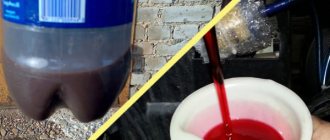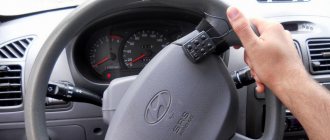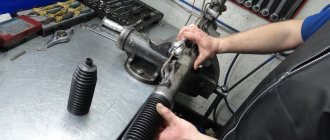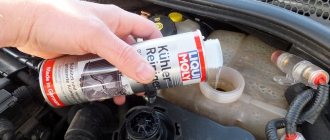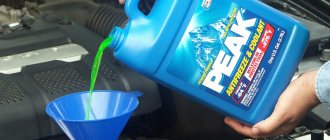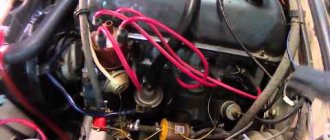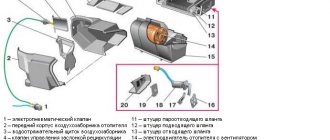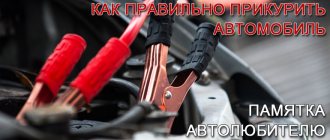If you hear a knocking, buzzing, squeaking or squeaking sound when you turn the steering wheel, this is not always a problem that needs to be addressed. For example, cars with power steering make quite a bit of noise (a slight hum) when you turn the steering wheel, which is typical for power steering systems. Another thing is that if this noise develops into rattling, squeaking or even knocking, or gets worse, then most likely you will have to call a mechanic.
Can you describe this noise? When you turn the steering wheel, is it a crunching, squeaking, humming, clicking, squeaking, etc.? It is very important that you are able to properly characterize this type of sound. In any case, below for each symptom we will look at additional tips to find the exact problem. But it is still necessary to take into account the following nuances of this noise:
- What is the nature of the noise: knocking, grinding, buzzing, squeaking, squeaking or something else?
- Does this only happen when you turn the steering wheel, while cornering or under other circumstances or during other activities?
- Is the noise always audible or does it depend on the weather, air humidity, heating of suspension/steering components, vehicle load, etc.
- Do you hear noises when you turn the steering wheel left, right, or both ways?
- What additional symptoms or problems occur with this noise?
Answering all of these questions will provide valuable information to properly diagnose steering noise.
The front of the car performs many different tasks:
- prevents the vehicle from tipping over when cornering;
- moves wheels up and down to soften them;
- allows you to turn the wheels using the steering wheel;
- transmits power from the engine to the wheels that drive the vehicle in front-wheel drive vehicles.
However, there are many reasons why your front suspension and steering may wear out. Fortunately, as these components wear out, many of them begin to make strange noises, warning that they need to be replaced, lubricated, or repaired. However, by the time they start making sounds, they are usually very close to failure, so it is best to have the device diagnosed as soon as possible. Some of the sounds made when turning the steering wheel are tapping sounds, others are squeaking sounds, and some are humming noises, etc.
Here's a list of all the noises your car may make when you turn the steering wheel and the possible problems associated with them. This is a starting point for diagnosis, but remember that this is not an exhaustive list of possible causes. So what could be the reasons for knocks, squeaks, noise when turning the steering wheel?
Noise when turning the steering wheel in place
This type of noise when turning the steering wheel while the vehicle is stationary is typical for vehicles with power steering. This is normal for any vehicle with power steering. If you're getting into your car for the first time and hear this little hum, know that it will accompany you quite often. In very rare cases, noise may only appear when the steering wheel is turned in one direction: left or right.
However, if you have owned the car for a long time and the noise has apparently become louder, not only when turning the steering wheel in place, but also while driving, you should probably have the CPS checked. Don't worry, the most common problem with this symptom, such as a buzzing sound when turning the steering wheel, can be easily resolved by adding CPS fluid. It is enough to check its level under the hood (a special reservoir with markings of the minimum and maximum fluid levels and identification, in most cases, that it is exactly the same CUR fluid). Low fluid levels may indicate a possible leak, so check the level at least once a week first.
Other problems that can cause these symptoms could be a faulty power steering pump, air in the hydraulic system, or a loose power steering. In this case, only a specialized service will help.
Almost all of the listed power steering malfunctions occur, in addition to a roar when turning the steering wheel, which is made even more difficult by turning the steering wheel.
Why is the power steering noisy, the main reasons
Power steering was installed on cars back in the Soviet Union; at first, hydraulics were used on MAZ trucks. The first passenger car in Russia equipped with a hydraulic booster was the executive ZIL-111, which was produced since 1958. If earlier cars had a worm-type gearbox, then almost all modern cars are equipped with a rack-and-pinion steering mechanism, and the entire hydraulic system is sealed. In addition to the rack, the steering system has:
- metal tubes and rubber hoses through which liquid flows;
- High pressure pump;
- filler tank.
The power steering pump is driven by the engine using a belt, creates a certain pressure, and for each car model it can be different, but on average - from 80 to 150 Bar (from 8 to 15 MPa). The upper pressure threshold is limited by a pressure reducing valve located in the pump; a special liquid is poured into the system; on some car models, transmission oil for automatic transmissions is used.
A hum in the power steering may occur in the following cases:
- fluid leaks out and there is not enough of it in the system;
- steering rack is faulty;
- the system is airy;
- The power steering pump is worn out and needs to be replaced;
- the drive belt is loose;
- a liquid that does not meet the specifications has been filled.
A humming noise in hydraulic steering is acceptable in extreme steering positions, regardless of the car - VAZ, Audi or BMW. The fact is that when the wheels are turned all the way to the right or left, maximum pressure is created in the hydraulic system, and it is not recommended to keep the steering wheel turned all the way for a long time, as the pump may burn out.
Knocking noise when turning car while moving
Another symptom is a characteristic knocking sound when entering a turn. Moreover, the knocking noise can become stronger the lower the steering angle and the worse the road surface. This knocking noise is typical for worn shock absorbers - they simply stop working properly and require replacement. Because shock absorbers on the same axle do not always wear evenly, rattling noise is usually heard when turning one way rather than the other.
Another sign, in addition to knocking when cornering, is the presence of knocking on uneven surfaces, even when driving in a straight line. The fact is that shock absorbers are subject to greater loads when cornering and knock more often. Also pay attention to the presence of wet spots on the shock absorbers - this may indicate a leak.
If your car is much older, has a high mileage (we will not give numbers, because shock absorbers can be damaged in different models, and many other factors influence this), the shock absorbers are at risk (illness of your model, about which You can find out on the thematic forum or from the dealer) it is quite possible that the cause of the knocking on corners is the shock absorbers. This can be checked by visiting a professional mechanic.
Knocking sound when turning the steering wheel with play in the steering wheel
Although steering joints do not require maintenance for almost the entire life of the vehicle, they are subject to wear and tear on our roads. The main sign of wear on the steering joints is their looseness with the appearance of play and a characteristic but quiet knock when the steering wheel is first turned. The best way to determine the cause of this knocking noise when turning is to stand on a level surface and try to turn the steering wheel from side to side - first with small movements of the steering wheel, and then more and more until you detect play and knocking. You can also get out of the car, look at the wheels and do the same work with the steering wheel through an open car window or door. If we notice that when turning the steering wheel through a small amplitude, the wheels remain motionless, there is play in the steering system that should be eliminated.
This defect can be eliminated by asking a specialist to diagnose all connections for wear and play, then replace worn joints and connections and tighten the corresponding mechanisms that create play in the steering system.
Creaking or grinding noise when turning the steering wheel both at a standstill and while moving
Another noise you may hear coming from the steering wheel and in response to its rotation is a squealing or grinding noise. These sounds are also usually a sign of worn joints in the steering system or front suspension. As in the previous case, it is necessary to diagnose the steering or suspension joints and replace them if necessary.
However, the most common problem associated with this symptom is that the steering wheel ends are worn out or lack of lubrication.
Additionally, shock absorber bearings or lower ball joints may make a squealing (sometimes even crunching) noise when you turn the steering wheel, whether the vehicle is stationary or moving. In the latter case, an additional symptom is wheel play when the car is on the ground.
Poor quality ATF fluid
If it has not been changed for several hundred thousand kilometers, if it is black or dark in color, if it also smells “burnt”. This fluid needs to be changed urgently. From heavy loads, from many circles in the power steering system, it becomes dirty, diluted, burns out, and generally turns into who knows what. It can no longer work normally in the system, lubricate the pump, seals and other elements, which is why noise appears.
The quality is checked simply by eye, unscrew the cap and look into the tank, the liquid should be light red, or, in extreme cases, dark red. If it is black and there are inclusions of fibers (this type of micro crumb), it urgently needs to be changed - it makes a buzzing noise.
In general, make it a rule to change it after a mileage of 80 - 100,000 kilometers. If conditions are difficult, then after about 70,000 km.
Crunching when cornering in front wheel drive cars
It happens that the car is noisy even when turning. Moreover, the sharper the turn and the higher the speed, the more characteristic and louder the crunch. This crunch does not seem to be dependent on the wheel turning, but is due to the turning maneuver on the road and comes from the wheel under load, i.e. the wheel on the outside of the turning path. In this case, the crunch most often occurs when turning only in a certain direction: right or left.
This crunch is typical only for front-wheel drive or all-wheel drive vehicles. The reason for the crack when rotating is a ball joint, more commonly known colloquially as a “grenade”.
The CVG is a joint that allows the front wheel to rotate in all directions at a certain angle while maintaining a constant axle speed. Because the CVG is constantly rotating and subjected to heavy loads, it sometimes wears out and needs to be replaced.
The condition of the joints in the car can be checked by turning the steering wheel all the way, and then slowly and a little faster in a circle, first in one direction and then in the other direction. If you hear a crunching noise while performing this maneuver, your CVG has worn out. Attention: if the crunch is accompanied by vibration, the car should be taken to a specialized service as soon as possible.
The CVT should always be run with a dust boot, which protects the system from dirt and dust. It often wears out due to the vacuum cleaner breaking down. And the crunch of a pomegranate is nothing more than the crushing of dirt particles inside it or the crumbling of pomegranate bearings.
Your vehicle is an extremely complex system, and the steering and suspension systems are made up of many components and vary in structure, operation and components depending on the model, and often even between variants of the same model. Therefore, this noise may indicate not only everything that we listed above. Often, steering columns, tie rods, steering knuckles, shock absorbers and joints make all sorts of sounds. Even a simple play or loose part of a completely disconnected steering or suspension can, for example, cause the steering or suspension components to bounce when the steering wheel is turned or hit, respectively.
However, the best course of action if this noise occurs when turning the steering wheel or the entire vehicle is to first identify additional noise symptoms (steering wheel movement, better identification of the sound). Next, check all the steering and suspension boots under the car, check the steering wheel, and then check the wheels for play.
Why is the power steering humming and how to fix it
Despite the apparent simplicity of the design of the power steering system, the operating principle of this system is quite complex. This is an auxiliary element of the steering system and if it fails, there will be no complete loss of steering, but it will be difficult to control the car. The situation is especially dangerous when the power steering stops working while driving, and it is difficult for the driver to immediately get used to the “heaviness” of turning the steering wheel caused by the reduced maneuverability of the car.
If the power steering hums when turning, there may be several reasons for this:
- The power steering fluid level has dropped. If the driver does not monitor the power steering fluid level, low fluid levels can cause problems with noise when turning the steering wheel. In such a situation, it is necessary to replace the fluid in the system and carry out diagnostics after identifying the cause of the drop in the fluid level. Most often, power steering oil leaks are due to problems with the rack or pump;
- Low quality fluid in the power steering reservoir. There are some automotive consumables that you can't skimp on, and power steering oil is one of them. Its cost is not high enough to select the cheapest replacement options, and saving on working fluid can result in serious damage to the system, which will require replacement of expensive parts.
Replace the oil in the power steering system when its service life has expired. Good fluid should be changed approximately every two years (or every 70,000 to 80,000 miles). There is a common way to check your power steering fluid to determine if it is in good condition. To find out whether replacement is required, unscrew the cap of the expansion tank and use a syringe (or dropper) to draw a little oil from it. Then drop it on white paper and look at the color. “Clean” power steering fluid should not be black or brown. Acceptable colors are burgundy, crimson or red. Check the smell of the power steering fluid; it should not smell like burnt rubber.
- Faults related to the steering mechanism. One of the most annoying problems that a power steering assembly can cause is when the steering wheel begins to make a buzzing noise. If the fault is in the strut, have the strut and power steering diagnosed at a service center. In some situations, an expensive steering gear replacement may be required.
- The power steering drive belt is loose. If the power steering belt is loose or very worn, a droning sound may be heard when turning the steering wheel. In this case, the driver can buy a new belt himself and replace it;
- Air enters the power steering system. There are two common causes of air being trapped in a system: air in the system during a fluid change and air entering through loose connections. In this case, find and fix the cause of the problem. Next, flush the power steering system, replace the oil with new oil, and properly bleed the system to remove any remaining air. Be aware that if air gets into the power steering system, the fluid in the reservoir will begin to foam.
- Malfunction of the power steering pump. This fault is easier to identify than others. If the power steering pump fails, the system essentially stops working, causing the steering wheel to become stiff and a humming sound to be heard when the steering wheel is turned. Most often, pump problems arise from a faulty impeller, bearing or seals. The power steering pump is rarely repaired, and if it fails, this part will need to be replaced.
Most causes of power steering buzzing when turning can be diagnosed and corrected yourself. However, it is better not to lead the situation to serious problems, but to operate the system correctly.
Power steering hums when cold
Troubleshooting power steering and steering rack
There are several reasons why the power steering hums when cold. The first is that air is leaking through the low pressure lines . To eliminate it, it is enough to put two clamps on the tube going from the reservoir to the power steering pump. In addition, it is worth replacing the ring located on the suction pipe of the pump itself. After installing the clamps, we recommend that you use an oil-resistant sealant to coat the clamps and joints.
You can also conditionally identify another reason, the probability of which is low. Sometimes there are cases when insufficient (poor quality) pumping of the power steering system . In this case, an air bubble remains at the bottom of the tank, which is removed using a syringe. Naturally. that its presence can cause the indicated hum.
Elimination methods may include replacing oil hoses and/or racks, replacing the power steering pump, installing additional clamps on all hoses in order to prevent air leaks into the system. You can also perform the following procedures:
- replacing the O-ring on the expansion tank supply spout;
- installing a new hose from the reservoir to the pump using oil-resistant sealant;
- perform the procedure for expelling air from the system (when performing the procedure, bubbles will appear on the surface of the liquid, which must be given time to burst) by turning the steering wheel with the engine not running;
Another repair option is to replace the O-ring in the power steering pressure suction hose (and, if necessary, the hose itself and both clamps). The fact is that over time it loses elasticity and becomes rigid, that is, it loses elasticity and tightness, and begins to let air through, which enters the system, causing knocking and foam in the tank. The way out is to replace this ring. Sometimes a problem can arise because it can be difficult to find a similar ring in a store. But if you find it, be sure to replace it and place it on the mount and lubricate it with oil-resistant sealant.
For some cars, a special power steering repair kit is available for sale. If problems arise with this unit, the first thing you need to do is buy a repair kit and change the rubber gaskets that are included in it. Moreover, it is advisable to buy original kits (especially important for expensive foreign cars).
Power steering pump bearing
It is also necessary to ensure that there is no dirt in the system fluid . If it is present even in small quantities, over time this will lead to wear on the parts of the power steering pump, which will cause it to begin to make unpleasant sounds and work worse, which will be expressed in increased effort when turning the steering wheel, as well as possible knocking. Therefore, when replacing the fluid, be sure to check for dirt deposits at the bottom of the expansion tank. If they exist, you need to get rid of them. Check the filter in the tank (if there is one). It should be relatively clean and intact, tightly adjacent to the walls of the tank. In some cases, it is better to replace the entire tank and filter rather than try to clean them. Also in this case, it is necessary to remove the rail, disassemble it, wash it from dirt, and also replace the rubber-plastic parts. To do this you need to use the mentioned repair kit.
An unpleasant sound may come from the outer bearing of the power steering pump . Its replacement is easy, without the need to completely disassemble the unit. However, sometimes it can be difficult to find a replacement for him.
There are special additives that are added to power steering fluid. They eliminate the hum of the pump, relieve effort on the steering wheel, increase the clarity of the power steering, reduce the level of vibration of the hydraulic pump, and protect system parts from wear when the oil level is low. However, motorists have different attitudes towards such additives. They really help some, but they only harm others and speed up the time for replacing the power steering pump or replacing it.
Therefore, we recommend that you use additives at your own risk. They only eliminate the symptoms of the malfunction and delay repair work on the pump or other elements of the power steering system.
When choosing a liquid, pay attention to its temperature characteristics so that it works normally in severe frosts (if necessary). Since oil with high viscosity will create obstacles to the normal operation of the power steering system.
Possible causes of hum
The power steering mechanism itself is quite simple, so if necessary, you can always figure it out yourself. Accordingly, if you hear a hum from the power steering, a whistle when heating or cold, and the unit is humming, you can find the cause yourself. However, in order to understand why the power steering hums when cold or hot, it is necessary to diagnose the symptoms. Today, experts identify several possible signs that can provoke a stir.
Schematic diagram of a car's power steering
So why does it start to hum when you turn on a warm or cold engine and what to do in such cases? One of the main reasons is the poor condition of the oil in the system. It's no secret that any consumables in a particular car system do not last forever, even though manufacturers ensure that oil is filled throughout the entire life of the car. Therefore, if the hydraulic shock absorber howls, one of the reasons may be the used material.
If you don't change the fluid promptly, you will feel howling in both hot and cold conditions, so the first thing you need to do is check the condition of the oil. The working substance must have a basic level, it must also be optimal, so if we find that there is not enough oil in the system, it would be better to top it up. It is not recommended to mix oils only when they fully correspond to each other in composition and additives. As for the frequency of replacement, it depends on the use of the vehicle, but on average this fluid is changed every two years.
If the lubrication is really bad, you will notice that the steering wheel becomes harder to turn when the car is cold and the engine is hot. So, if you go the extra mile to hear a whirring sound, chances are the problem is with the supplies.
The dust cover of the steering mechanism is damaged.
Another reason why the system whistles when making cold or hot turns is due to improper operation of the steering mechanism, as a rule, the reason for the failure of the device is temperature. Due to sudden temperature fluctuations, the mechanism may not work correctly.
In addition, the noise is caused by salt entering the system, which remains on the roads after it is covered with ice. If salt gets on parts of the device, such as oil seals and dust caps, it will corrode them, and as a result the device hisses not due to corrosion of the seal, but due to the resulting oil leak. To fix the problem, you need to remove the device and repair it.
Practice shows that in most cases it is not easy to repair, so the problem is usually solved by replacing the element. In addition, the power steering often whistles due to wear or weakening of the drive belt; if so, then the first step is to carry out a diagnosis. If the unit squeals when turning, try tightening the belt, but if it is worn enough, replace it. If the noise occurs regularly, it can eventually affect the car's handling, especially since the appearance of such sounds can contribute to vibration of the steering wheel (film author - Chevrolet Aveo).
The pump needs to be separated. Since its main function is to supply working fluid to the device, if it fails, oil may enter the system irregularly or not at all. In this case, the hydraulic fluid whistles. If the problem is truly the efficiency of the pump, replace it. The bearing may also whistle.
Causes of hum
- Low fluid level in the power steering system. You can check this visually by opening the hood and looking at the oil level in the power steering expansion tank. It should be between the MIN and MAX marks. If the level is below the minimum mark, then it is worth adding fluid. However, before doing this, you must definitely find the cause of the leak. Especially if a little time has passed since the last top-up. As a rule, leaks occur at clamps and at joints. Especially if the hoses are already old. Before topping up, be sure to eliminate the cause of the leak .
- The filled liquid does not match the one recommended by the manufacturer. This can cause not only a hum, but also more serious malfunctions. The power steering also due to the fact that, although the fluid meets the specification, it is not intended for operation in special temperature conditions (in significant frosts).
Dirty power steering fluid - Poor quality or contamination of the fluid in the system. If you purchased “burnt” oil, then there is a high probability that after some time it will lose its properties and the power steering will begin to hum. As a rule, along with the hum, you will feel that it has become harder to turn the steering wheel. In this case, be sure to check the quality of the oil. As in the previous case, open the hood and look at the condition of the fluid. If it has become significantly blackened, and even more so, crumpled, it is necessary to replace it. Ideally, the color and consistency of the oil should not differ much from new. You can check the condition of the liquid “by eye”. To do this, you need to take a little liquid from the tank with a syringe and drop it onto a clean sheet of paper. Red, raspberry burgundy, green or blue colors are allowed (depending on the original used). The liquid should not be dark - brown, gray, black. Also check the smell coming from the tank. It shouldn't smell like burnt rubber or burnt oil. Remember that the fluid must be replaced in accordance with the schedule approved in your car’s manual (as a rule, it is changed every 70-100 thousand kilometers or once every two years). If necessary, change the oil. You will find a list of the best fluids for the power steering system in the corresponding material.
- Air entering the system . This is a very dangerous phenomenon that is harmful to the power steering pump. Check for foam in the hydraulic system expansion tank. If this occurs, then it is necessary to bleed the power steering or replace the fluid.
- Steering rack malfunctions .
It can also cause a hum. It is worth carrying out a visual inspection and diagnosis. The main signs of a rack malfunction are a knocking sound in its body or from one of the front wheels. The reason for this may be failure of the gaskets and/or damage to the steering rod boots, which can result in leakage of working fluid, dust and dirt getting onto the rack, and knocking noise. In any case, it is necessary to repair it using repair kits sold in auto stores. Or ask a service station for help. Do not drive with a faulty steering rack, as this may cause it to jam and cause an accident. - Loose power steering drive belt . Diagnosing this is quite simple. The procedure must be performed after the engine has been running for some time (the longer, the easier it is to diagnose). The fact is that if the belt slips along the pulley, it becomes hot. You can verify this by touching it with your hand. To tension, you need to know the force with which the belt should be tensioned. If you don’t have a manual and don’t know the effort, go to the service center for help. If the belt wears excessively, it must be replaced.
- Power steering pump malfunction . This is the most unpleasant and expensive breakdown. Its main symptom is an increase in the effort with which you need to turn the steering wheel. The reasons why the power steering pump is humming can be various failed parts of the pump - bearings, impeller, seals. You can find methods for diagnosing and repairing power steering in another article.
Troubleshooting power steering and steering rack
There are several reasons why the power steering hums when cold. The first is that air is leaking through the low pressure lines . To eliminate it, it is enough to put two clamps on the tube going from the reservoir to the power steering pump. In addition, it is worth replacing the ring located on the suction pipe of the pump itself. After installing the clamps, we recommend that you use an oil-resistant sealant to coat the clamps and joints.
Elimination methods may include replacing oil hoses and/or racks, replacing the power steering pump, installing additional clamps on all hoses in order to prevent air leaks into the system. You can also perform the following procedures:
Another repair option is to replace the O-ring in the power steering pressure suction hose (and, if necessary, the hose itself and both clamps). The fact is that over time it loses elasticity and becomes rigid, that is, it loses elasticity and tightness, and begins to let air through, which enters the system, causing knocking and foam in the tank. The way out is to replace this ring. Sometimes a problem can arise because it can be difficult to find a similar ring in a store. But if you find it, be sure to replace it and place it on the mount and lubricate it with oil-resistant sealant.
It is also necessary to ensure that there is no dirt in the system fluid . If it is present even in small quantities, over time this will lead to wear on the parts of the power steering pump, which will cause it to begin to make unpleasant sounds and work worse, which will be expressed in increased effort when turning the steering wheel, as well as possible knocking. Therefore, when replacing the fluid, be sure to check for dirt deposits at the bottom of the expansion tank. If they exist, you need to get rid of them. Check the filter in the tank (if there is one). It should be relatively clean and intact, tightly adjacent to the walls of the tank. In some cases, it is better to replace the entire tank and filter rather than try to clean them. Also in this case, it is necessary to remove the rail, disassemble it, wash it from dirt, and also replace the rubber-plastic parts. To do this you need to use the mentioned repair kit.
There are special additives that are added to power steering fluid. They eliminate the hum of the pump, relieve effort on the steering wheel, increase the clarity of the power steering, reduce the level of vibration of the hydraulic pump, and protect system parts from wear when the oil level is low. However, motorists have different attitudes towards such additives. They really help some, but they only harm others and speed up the time for replacing the power steering pump or replacing it.
When choosing a liquid, pay attention to its temperature characteristics so that it works normally in severe frosts (if necessary). Since oil with high viscosity will create obstacles to the normal operation of the power steering system.
If the power steering hums when hot, then there may be several problems. Let's look at several typical situations and methods for solving them.
Main components of power steering
The power steering system consists of several important components; failure of any of them can lead to failure of the entire unit:
- The power steering pump that turns on when the engine starts. Its job is to pump oil from the reservoir and distribute it throughout the system.
- The oil reservoir itself.
- Fluid distributor for hydraulic cylinders - activated when the steering wheel is turned.
Many car owners believe that the oil in a hydraulic unit is designed for the entire service life of the car. However, this is not true - you will still have to change it. The service also involves constantly checking the level of working fluid in the tank. If the oil is partial If the leak reaches a critical level, the power steering will hum and then simply stop working.
Bearing
When you hear a power steering hum when you turn the steering wheel, it could be the fault of a damaged outer bearing. It is replaced with a new one after dismantling the pump. It is advisable to remove the bearing using a three-legged puller, without the need to disassemble the unit. This will prevent damage to the shaft. Along with it, the drive belt, reservoir, and repair kit are changed.
It is noteworthy that the power steering noise in this case will more closely resemble a whistle. Noticeable more often in the mornings, when the car is not yet warmed up. It may practically not show itself when the engine is hot. As a rule, there are practically no other reasons why the power steering pump hums.
The power steering hums when you turn the steering wheel
The power steering may whine when you turn the steering wheel, but when the car is moving straight forward there is no audible whine. The same thing happens with a stationary car:
- When the steering wheel is stationary, the power steering is silent;
- There is a noise when turning the steering wheel.
There are also several different causes of noise:
- the fluid level is low (leaking) or needs to be replaced;
- there is air in the system;
- the pump needs to be repaired or replaced;
- The steering is damaged.
If there is not enough fluid or it has been completely flushed, the steering wheel buzz disappears, but the steering wheel becomes heavy and clunky. There are drivers who do not pay attention to a tight steering wheel and continue to drive the car, but this ends badly: the steering rod elements begin to wear out intensively and need to be replaced quite quickly.
Design and operating principle
To quickly find the reasons for the buzzing of the power steering, you need to understand its structure and operating principle.
Structurally, the power steering is very simple and includes the following main components:
- Pump;
- Distributor;
- Working cylinder;
- Pipelines (high and low pressure);
There are several design versions of the unit, but on passenger cars power steering is used, in which the distributor and working cylinders are integrated into the steering mechanism.
In this design, the distributor is connected to the steering column shaft, the mechanism body acts as a cylinder, and its piston is mounted on a rack. The working element of the mechanism is a special oil.
The principle of operation of the power steering is as follows: the pump constantly pumps oil, creating pressure in the system, from which it flows through the high pressure line to the distributor.
If the wheels are level while driving, then the working fluid from the distributor through the low-pressure line returns back to the pump, that is, it constantly circulates in a circle.
When the steering wheel is turned, the steering column shaft moves the distributor spool, thereby opening the fluid supply channel into the desired cylinder cavity.
The oil, having filled this cavity, begins to put pressure on the piston, thereby helping the rack to move. When the steering wheel stops rotating, the spool immediately moves to the neutral position and the fluid stops acting on the rack.
A simplified circuit is described above, which is sufficient for a general understanding of the operating features of the amplifier.
READ MORE: Steering control, structure and principle of operation.
Grinding, as well as squeaking (the steering wheel turns both when driving and when standing still)
When turning the steering wheel in different directions, a grinding/grinding noise is felt. This type of noise is caused by wear on the linkage or tie rod joints. by analogy, as in the previous paragraph, here it will be necessary to diagnose the suspension or steering components, replacing worn parts if necessary.
However, the most common cause of this noise is a lack of lubrication at the ends of the handlebars (as well as significant wear on them).
Sometimes this squeak may even be accompanied by a crunching sound, regardless of whether the car is moving or standing still. In this case, the lower ball joints (sometimes also the shock absorber bearings) are to blame. The first option is also accompanied by play in the steering wheel when the car is suspended.
Power steering hums after replacement
Sometimes after changing the oil the power steering starts to hum. An unpleasant noise may be caused by the pump in the housing if the system was filled with less thick oil than before. The fact is that increased wear is observed between the inner surface of the stator ring and the rotor plates. The plates also vibrate due to the uneven surface of the stator.
To prevent this from happening, we recommend using oil recommended by the manufacturer. Thanks to this, your car will not break down in the system.
It is also possible to hear a humming noise after replacing the high pressure power steering hose. One of the reasons may be poor quality of the hose. Some sites are offended by installing regular hydraulic lines instead of special hoses designed to handle the high pressure of the steering hydraulic system. This may cause suffocation of the system and subsequent noise. The remaining reasons are largely similar to the above-mentioned cases (knocking on cold, hot).
Is repair necessary if the power steering is humming?
If the hydraulic booster is noisy and the cause of the malfunction has not yet been identified, you can try to diagnose it yourself. To do this you should:
- place the car on a dry, level place;
- start the engine;
- carry out an external inspection for fluid leakage;
- remove the cap of the power steering filler tank and check the level in it;
- pay attention to the color of the liquid, whether it has darkened;
- Turn the steering wheel and make sure that no air bubbles appear in the tank (this diagnosis needs to be done by two people).
If the fluid is gone, it should be added, but first you need to find the cause of the leak and fix the problem.
After topping up, it is necessary to bleed the system and remove air from it, otherwise the howling of the hydraulic booster will continue. It’s easy to pump the power steering, but it’s also easier to do this kind of work with two people. We proceed as follows:
- one of the participants starts the internal combustion engine, turns the steering wheel all the way to the right and left several times;
- another looks to see if there is air in the power steering reservoir and if the fluid is leaving, and if necessary, tops up;
- after rotating the steering wheel 5 or 6 times, you need to make sure that the hum has stopped and the system is no longer leaking air;
- If the defect is not eliminated, you should try this procedure several more times.
Unfortunately, it is not always possible to restore normal steering function, and if the hum continues, the power steering pump is probably to blame. Usually this part is changed, and even repaired in car services (there are repair kits), but repair is not always justified - what the result will be is unknown. For many car models, the pump is inexpensive, especially if it is not original. For example, a Ford Focus-1 power steering pump can cost approximately 60-80 dollars; it is possible that restoring the unit will cost no less.
How to fix problems
In about half of the cases, a hum in the power steering pump indicates wear. It is impossible to know for sure without disassembling and inspecting the internal parts. Therefore, there is an algorithm of actions that excludes simpler causes:
- Open the expansion tank cap. Check the fluid level. If the level is insufficient, add oil to the Max mark. Be sure to find out what kind of fluid is needed for your car's power steering. After that, look for a leak. In the hydraulic booster system, the seals of the rack or pump shaft seals are most often broken.
- Start the engine. Pay attention to whether there are any bubbles in the reservoir when the power steering is operating. If you find bubbles, turn the steering wheel to its extreme position 5-10 times. This procedure will expel air from the system. If the extraneous sound becomes quieter or disappears for a while, the reason most likely lies not in a worn pump, but in poor working fluid or air leaks.
- Assess the condition of the oil in the expansion tank. Manufacturers color power steering fluids red, yellow or green. If the oil has lost its transparency, noticeable foreign inclusions have appeared in it, or it has turned black, replace it.
After the above procedures, the hum in about half of the cases subsides or disappears completely. Otherwise, the hydraulic pump will need to be dismantled, rebuilt, or replaced.
Special additives will extend the life of a worn power steering pump. You can use additives in power steering oil if you plan to replace the hydraulic pump rather than overhaul it. The cermet layer formed on the working surfaces will complicate or eliminate repairs. According to the analysis of numerous reviews from car owners, additives do help eliminate power steering hum, but not in all cases and for a short period of time.
Summarize. A noisy power steering pump will not affect the car's handling, but will only cause discomfort from an extraneous hum. In some cases, the cause of loud operation of the hydraulic booster can be eliminated without serious repair operations by replacing (topping up) the working fluid or eliminating air leaks. If this does not help, the pump will need to be replaced or rebuilt.
Replacing steering fluid
Any vehicle periodically requires repair and maintenance, and the steering also needs to be maintained in good technical condition. In order for the hydraulic booster to work longer, the fluid in the mechanism must be changed in a timely manner; usually the replacement is done once every two years. Similar work is also performed if:
- the liquid has darkened, dirt, various impurities are found in it, or there is a burning smell;
- the car was purchased recently, and it is not known what is in the power steering reservoir;
- The power steering hummed, there is an assumption that after the fluid is replaced, the hum will disappear.
It is not difficult to change the fluid in the steering hydraulic system; we carry out the work in the following order (using the example of the Hyundai Getz):
- turn off the engine, open the hood;
- jack up the front of the car, hang it on trestles so that the front wheels can rotate freely;
- Unscrew the cap at the power steering reservoir;
- We prepare a container for waste (a plastic bottle), take a syringe, and use it to pump out the contents of the tank;
- Use pliers to loosen the clamp, then pull off the return hose;
- we make a homemade plug (it can be made from a piece of an old hose and an unnecessary candle), attach this device to the fitting;
- we lower the end of the removed pipe from the power steering reservoir into a plastic bottle, and then the work needs to be done together - one person holds the container, the second rotates the steering wheel to the right and left, briefly holding it in the extreme positions;
- liquid from the system will begin to be pumped into the bottle; approximately 0.5 liters should come out of the steering;
- then you can flush the system - pour about 0.2 liters of fresh liquid into the tank, repeat the whole operation again;
- after washing, remove the plug, replace the pipe, and secure the clamp;
- we fill the system with new fluid, while simultaneously rotating the steering wheel, also holding it for several seconds in extreme positions;
- after air bubbles stop coming out of the tank, the operation can be considered complete. All the air must be expelled, otherwise after starting the engine the liquid will foam and the power steering pump will hum.
This is interesting: Do-it-yourself replacement of optics, headlight bulbs, side lamps on a Hyundai Solaris
There is no need to start the engine while bleeding air, but add enough new fluid so that it is at a level between the MIN and MAX marks. Typically, for refueling including flushing on a Hyundai Getz car, no more than 1 liter of liquid is required; at the end of the operation, we lower the front wheels into place, and after starting the engine, we top up the system, if necessary.
How to avoid power steering breakdowns
Hydraulic steering systems are quite reliable and, when used correctly, rarely fail. System manufacturers recommend following the following rules:
- When parking your car, do not forget to align the wheels. This will reduce the load on the power steering system when starting the engine. It is especially important to follow this rule in winter, since the fluid in the power steering reservoir may thicken when parked and starting the system will be “difficult”;
- Don't forget to check the power steering fluid level and replace it if necessary;
- Minimize the amount of time the steering wheel is in the full right and full left positions. It is recommended not to leave the steering wheel in extreme positions for more than 10 seconds, otherwise there is an increased risk of failure of the power steering pump;
- Check the condition of the dust covers, steering rack and ends. If these parts are repaired in time, damage to the steering and power steering can be avoided.
Don't forget to align your wheels when parking your car. This will reduce the load on the power steering system when starting the engine. It is especially important to follow this rule in winter, since the fluid in the power steering reservoir may thicken when parked and it will be difficult for the system to start;
If you feel like your power steering is worn out (the steering wheel turns sharply or you hear a buzzing sound when turning), contact a service center immediately or try to fix the cause of the problem yourself. By delaying repairs, you risk damaging expensive structural elements.
Rules for proper use
If you don't want to face the problem of noise, the first thing you need to do is to use your car properly. The first thing to remember is that in cars with power steering, do not keep the steering wheel in the same position for too long when turning or maneuvering. This is because the steering assembly begins to heat up during operation, the same applies to the hydraulic fluid, and if the assembly is held in one position, the fluid may boil away. Therefore, without changing the lubricant, the problem cannot be solved.
It is also not recommended to leave the car with the wheels turned out for a long time, especially in winter, at low temperatures. This may also cause undesirable effects on the steering system. If you notice that some malfunctions have begun to appear, it is advisable to diagnose the car as soon as possible and fix the problem.
If there are serious damages, it is better not to even try to repair the device yourself, especially if you are not confident in yourself. The best option would be to repair the car in a workshop. Only early detection of faults in the system can ensure its long-term operation.
How to remove air from the power steering
If the power steering hums due to air in the oil, there is a very simple way to get rid of the problem:
- Start the car and let the engine idle for 5 minutes.
- Turn the wheel clockwise until it stops and leave for 5-7 seconds.
- Repeat the same procedure, turning the steering wheel all the way to the left.
After repeating this procedure several times, air will usually be released from the circuit. However, this method does not always work, so it is often necessary to remove the power steering. Do it:
- Disconnect the return hose from the tank, plug the hole with a plug made of waterproof material or a special plug.
- Immerse the disconnected end of the hose in a clean container.
- Start the engine and turn the steering wheel until the power steering pump begins to pump oil out of the power steering.
Repeat this operation until the foamed liquid stops flowing out of the system - clean oil should appear.
Air in the system
By the way, this happens all the time, the system sucks air from somewhere. By the way, it is often accompanied by not even a strong leak. For example, a tube, a hose, or sometimes even a sensor becomes snotty. The air doesn’t come in much, but it does, so you start to hum, wheeze, and so on. To be fair, it can hum without a leak, it just “grabs” a little air and that’s it.
We expel air from the system. Usually you need what is called - pumping the power steering. Turn the steering wheel five times to the right and left until it stops, with the power steering reservoir cap open. The air comes out and performance is restored and does not repeat. However, this is only when there is no leak. Otherwise, the next day everything will happen again.
The hydraulic booster is noisy when the car is not warmed up
Car owners often notice this phenomenon - the CPS hums when the engine is cold, and the lower the temperature, the stronger the howling is felt. The howling can last from 20-30 seconds to 5 minutes, after which the external sounds will disappear. Why this is so is impossible to answer unequivocally; each specific case must be considered individually. The most likely reasons for this phenomenon:
- the fluid in the car is of poor quality and thickens at low temperatures;
- The fluid level may be low and need to be checked;
- The noise is not coming from the power steering pump, but from the water pump bearing.
The power steering system uses fluids of different types and viscosities, so use what the manufacturer recommends. For example, Dexron VI is recommended for filling and refueling the power steering of the Chevrolet Cruze; ATF-type automatic transmission fluid is also acceptable.
Knock (steering wheel turns, car turns)
This sound accompanies the car when turning. It is worth noting that often a small steering angle and a bad road cause the car to make this rumble louder. The reason for this behavior of the car is the wear of the shock absorbers, which no longer absorb road irregularities. In this case, only replacing the shock absorbers with new ones will help. As a rule, the axle shock absorbers are worn to varying degrees, so the knocking noise can only be heard when the steering wheel is turned to the side.
A knock can occur not only when turning, but also when driving straight on a poor-quality road. When you turn the steering wheel, the shock absorbers are subjected to maximum load, so knocking occurs more often. Just in case, check the housings of the racks - there may be oil stains on them, which indicates oil leakage from the rack.
In a car with decent mileage (and the word “decent” means different things depending on the model), shock absorbers can fail (due to various factors). It is worth asking how susceptible your car is to such diseases on the official website or on the appropriate forum dedicated to your car brand. You can also immediately contact a specialist to diagnose the spacer.
The power steering hums in the left and right positions
It is important to know that when the wheels are fully turned, the power steering pump operates under the greatest load. As a result, extraneous sounds are produced that do not indicate any problems. Many car manufacturers report this in their owner's manuals. In this case, it is important to distinguish between noise caused by system faults and other noise.
If you know for sure that noise is the cause of the problem, perform diagnostics. The main causes of actuator humming in extreme positions are those that we discussed earlier. This means that you need to check the operation of the pump, the amount of liquid in the tank, the degree of tension of the power steering belt, the transparency of the liquid and the presence of impurities in it. Other situations are also possible.
Often on top of the gearbox is a valve box that is used to control hydraulic flow. When the steering wheel is turned to its extreme position, the flow of hydraulic fluid is blocked by the bypass valve and the fluid no longer flows in a small circle. This causes the pump to run independently, without cooling. This situation negatively affects her and leads to serious problems. For example, the pump door or cylinder may become stuck. In winter, when the liquid is thicker, this matters more. Therefore, the wheels should not be left completely out for long periods of time.
Is it possible to drive with the power steering humming?
You can drive when the power steering is humming, but it is not advisable. Let's explain why. The steering wheel is connected directly or through a cross to a worm shaft, which is also the force distributor shaft in the hydraulic booster. The worm shaft engages the steering rack rod. Rods are attached to the ends of the rod. They directly affect the steering knuckle of the hub.
In this kinematic chain all connections are rigid. And none of these connections will be broken if the power steering does not work well or even fails completely. The only thing that can happen is that the steering wheel will become tighter. On the other hand, a humming sound in the power steering pump indicates problems in the system. And if you don’t take action, the power steering will fail. The cost of a new hydraulic pump reaches 30 thousand rubles.
Tips for using power steering
In order for the power steering to work properly and not knock, you need to follow a few simple rules:
- Monitor the oil level in the power steering, top up and change it promptly. In addition, it is necessary to check its technical condition. There is always a risk of buying a low-quality liquid that will deteriorate after a short period of use (check its color and smell).
- Do not keep the wheels in the extreme position (both left and right) for a long time (more than 5 seconds). This is bad for an uncooled steering pump.
- Always park your vehicle with the front wheels pointing straight ahead (straight). This will relieve the hydraulic system the next time the engine is started. This advice is especially relevant in the cold season, when the oil thickens.
- If the power steering system malfunctions (rumble, knocking, increased effort when turning the steering wheel), do not delay repairs. Thanks to this, you will not only fix the problem at a lower cost, but also protect your car, yourself and your loved ones from possible accidents.
- Constantly check the condition of the steering wheel. This especially applies to the condition of dust caps and seals. Thus, you will not only extend its service life, but also save on expensive repairs.
It should be remembered that if the slightest signs of malfunction of the steering system, and in particular the power steering system, appear, it is necessary to carry out diagnostics and repairs as soon as possible. Otherwise, at a critical moment, you risk losing control of the car in case of steering failure (for example, a sprocket is jammed). Don't skimp on the condition of your car and the safety of you and your family.
Noisy when warm
When a buzzing sound occurs “on hot,” the source of the problem usually lies in the liquid. In this case, you first need to check its level and condition. The drop in level is described above, but the condition of the oil needs to be sorted out.
The performance of power steering largely depends on the viscosity of the working fluid. If the oil is not viscous enough, it will be more difficult for the pump to create the necessary pressure.
Over time, the oil loses its properties, including viscosity. After heating, it becomes too liquid, so the pump simply cannot create the required pressure. All this is accompanied by a buzzing sound and a heavier steering wheel.
The same can happen if the system is filled with oil that does not match the brand or is completely counterfeit. In this case, the liquid simply cannot perform its functions.
Another reason for the appearance of a buzzing sound when “hot” is wear of the components due to a large amount of dirt in the oil. Due to wear on the working surfaces, the required seal between them is not achieved and pressure losses occur. If the pump is worn out, some of the liquid will flow inside it and it will not be able to create the required pressure.
IMPORTANT TO KNOW: How to change power steering oil.
But humming can occur not only due to exhaustion in the pump, but also due to wear of the working cylinder and piston mounted on the rack. Due to the depletion in this unit, during power steering operation, liquid will flow from cavity to cavity through leaks, ensuring a pressure drop.
Restoring the functionality of the power steering and eliminating the buzzing sound “on hot” depends on the cause of its occurrence. If the inspection reveals severe darkening of the oil, it should definitely be replaced, preferably with flushing the system and replacing the tank.
As for the tank, it has a dirt-collecting mesh installed in it, which becomes heavily clogged over time, so this element should be changed when changing the oil, especially if it is dirty.
But some people get by with high-quality flushing of the tank. For replacement, you should use fluids recommended by the car manufacturer.
Wear on the components of the amplifier is eliminated by replacing the components. But since the cost of the pump or steering mechanism is significant, you can try to extend the service life by carrying out repairs using repair kits.
Replacing seals, seals, and bearings quite often helps solve the problem with power steering buzzing. Another inexpensive option is to fill the system with oil with high viscosity. Such a liquid, even after heating, will remain dense enough for a worn pump to create the necessary pressure.
